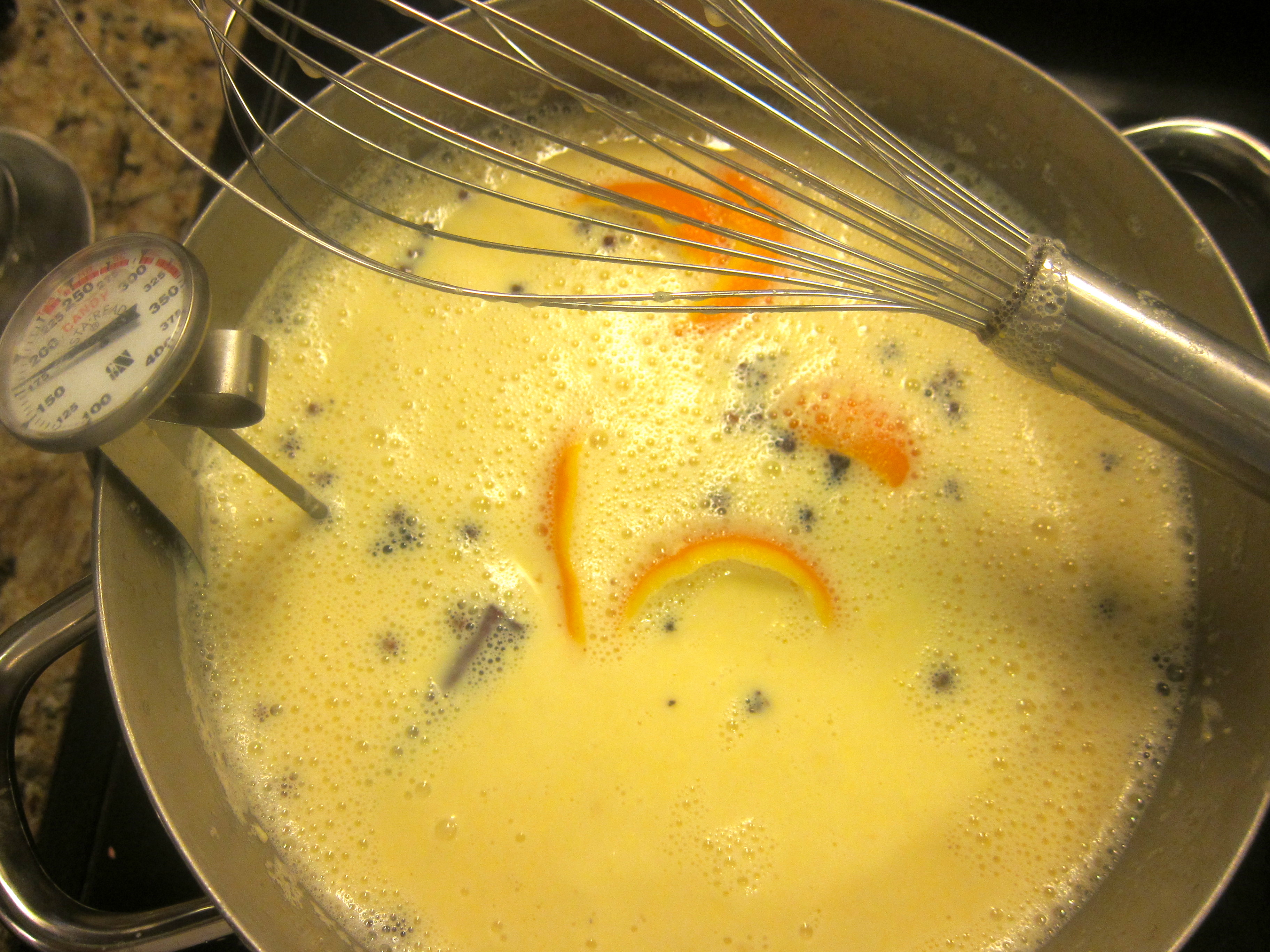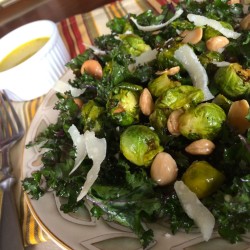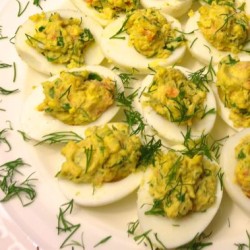Saturday, December 24, 2011
Looking for non-dairy nog? Click here.
—

Surely I can’t be the only person making eggnog this Christmas Eve? Alongside all of the other final preparations for the holiday, such as last minute shopping, gift wrapping and, of course, cookie baking, that is. All of this is in progress and will continue for a while, with requisite carols and symphonies filling the room with holiday music. Will it inspire you if I tell you my husband and I are also headed out for a ten mile run in a few minutes or will you just roll your eyes? Well, do with it what you will; there you have it. This is my idea of a wonderful Christmas Eve!
Now, I really must be getting back to all of the above, but I wanted to share my recipe for eggnog with you, as promised. It’s much lower in calories and saturated fat than most other recipes, and absolutely divine! Here’s the ingredient list and directions, along with a picture of what it looks like on the stove top.
Eggnog
Ingredients
- 2 dozen eggs
- 3/4 cup sugar
- 1 gallon skim milk (or 1/2 skim, 1/2 soy)
- 1-2 tablespoons honey
- 2 teaspoon vanilla extract
- 3 cinnamon sticks
- 1 tablespoon whole cloves
- Peel from 2 oranges

Instructions
In a large saucepan or pot, whisk up the eggs, then add the sugar. (If you use an electric beater, don’t overbeat and make it frothy.) Add the milk and cook slowly over medium-low heat, whisking constantly. More or less constantly, I’d say. I tend to multitask while waiting for this to cook but do be careful. There is a very fine line between eggnog and custard, as I’ve learned. The latter is delicious, but not to imbibe. Add the spices and peel from both oranges to flavor the nog, along with the vanilla and honey, stirring to combine. (Here’s a little holiday cooking challenge for you: Can you remove the orange peel in one long piece?)
It usually takes around 20-30 minutes or so for the nog to reach a temperature of about 160-170 degrees F (70 C or so), which you want to do in order to cook the eggs. When it reaches the correct temperature, remove from the heat and let it sit for 2-3 hours. It will thicken substantially, and may even look like custard at this point, especially if you used soy milk. Soy milk has more protein so it will lead to a more viscous product. Do not fret, my friends! This is normal. Next, obtain a large container and set a colander or sieve (like for sifting flour) on top. Pour the eggnog through, using a wooden spoon to move it through the sieve. This will remove the cooked eggs from the nog, which is the objective. This is much like straining my vegetable juice from way-back-when, actually; here’s the video if you’d like to check it out. This part does take patience, but it’s worth it for homemade eggnog, I assure you. If egg solids remain, the the holes in your colander are too large and you’ll need to switch to a finer sieve.
Once the eggnog is through the colander, it will be smooth. Take a taste. You can certainly adjust the seasoning, viscosity, or creaminess as you desire by adding a bit more of the above ingredients. I often find myself adding a bit more milk to thin it out and/or a bit more vanilla or honey to fine-tune the flavor. Your might add a little cream for body, though I don’t find it necessary you might if you’re used to a creamier beverage. As with most things culinary, making eggnog is as much art as science. Just remember: moving it through the sieve solves any unintended custard-like qualities that have transpired. Usually. Unless it’s really, really thick, in which case you’ve got yourself lovely homemade custard: perhaps make a trifle for dessert and run on out to the store to buy some high-quality store made nog.
Note. In another variation, I separate the whites from the yolks and add whipped egg whites to the cooked and cooled nog. This strategy breaks down the richness while adding a lot of lightness; both are great.
As you can see from the photos, mine is clearly a recipe for a big gathering of people, and it remains in the fridge all week for sipping and adding to coffee. (I usually drink coffee black but coffee with eggnog is a special Christmas treat in which I indulge yearly.) Alter the proportions accordingly if you have a smaller group.
There are so many different ways that people like to drink and serve eggnog. Straight up or on the rocks? With or without alcohol? Rum, brandy, Grand Marnier, whiskey, or bourbon? Garnished with freshly grated nutmeg? Topped with whipped cream? It’s up to you! I personally enjoy eggnog on the rocks spiked with bourbon, brandy, and/or Grand Marnier, along with a sprinkle of fresh nutmeg.
Finally, when serving in a punch bowl at a party, I like to leave the orange and spices in it because it looks pretty. Or, you can omit them during the original straining process. If you select the former option, do have a little strainer on hand for your guests to make sure you remove the cloves, orange peel, and cinnamon sticks when serving.
No need to hinder your holiday by having to perform the Heimlich, after all.
Happy Holidays!





eyeroll on the 10-miler!!! Merry Christmas!
We just got back, and ’twas a glorious run this brisk winter’s day in New England! Merry Christmas, my friend. Thanks for reading, and for the comment! I knew I could count on you for the eye roll; what are friends for, after all?
Love this! I always assumed that most eggnogs contained raw eggs, but this one sounds perfectly safe and perfectly delicious! Can’t wait to try it!
This is way too funny, even for me. I was going to make eggnog instead of buying the quasi-eggnog in a carton this year, and guess what I found when I did a search?
Cheers PK. I like it the same way you do but definitely with with the GM.
Enjoy! I actually have a non-dairy nog I made this year that I’ve been meaning to post, too. But you sound like an awesome cook so have fun with this, make it your own, and happy holidays! Cheers, PK